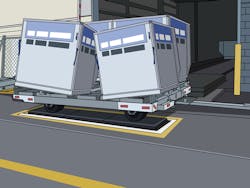“If you can count it, you can manage it” is a well-used business mantra, and is applicable to many aspects of air cargo operations. However, it is also worthwhile to consider a variation to this theme, the phrase “All that counts cannot be counted.” And when it comes to unit load device (ULD) operations, this “ditty” has considerable relevance.
So why should ULD be an exception? Surely, it is not so hard to measure the key performance indicators that are relevant to ULD and then apply some sound management principles. Problem solved – significant reductions in ULD damage, aircraft damage, unsafe loading practices, etc., right?
Well, not so easy. And the root of the problem lies in the operating environment in which ULD perform their essential flight safety task of safely securing cargo and baggage throughout all flight conditions, and protecting the aircraft and its systems from any kind of unplanned load condition.
This operating environment is characterized by two major factors, the first being that the majority of ULD operations – be they at a freight forwarder’s off-airport facility, be they in a cargo terminal or be they on the ramp – are typically carried out using manual or forklift operations, performed very often by high-turnover staff whose knowledge of the basic operating instructions for ULD are all too often inadequate for the job at hand.
And, to add to the equation, the daily challenge of getting cargo and baggage into ULD and ULD onto the aircraft, a safety critical function, is carried out in less-than-optimal conditions – including pressures to meet the flight schedule in addition to congestion on the ramp and in terminals. With many moving parts in the cargo flow, regrettably, the ULD component simply gets carried along. Many figure as long as enough ULD are available, then the rest can take care of itself.
Coming back to the opening thought, “All that counts cannot be counted,” this is very relevant to ULD.
What “counts,” very emphatically, is that each and every ULD that makes its way into the aircraft hold (whether it’s an AKH into an A319 hold or a 20-foot pallet onto a B747 main deck) must be both serviceable, with no damage that exceeds the stated limits for that particular ULD, and be correctly built up and secured.
Only when these two conditions are consistently met can it be said that the aircraft is safely loaded.
But how does one “count” these conditions? Herein lies the problem.
It seems practically impossible to implement a satisfactory level of oversight into ULD operations. The industry is not resourced to put in place sufficient oversight to closely monitor the condition of ULD as they make their way through the cargo chain and, sooner or later, end in an aircraft hold flying thousands of miles at 35,000 feet. Speak to any organization involved in this process and they will likely say “we put safety as our top priority,” and no doubt that is the intention.
Both airline and industry audits are expected to turn up any shortcomings, so surely all is well when it comes to ULD? Sorry to say, that is far from the truth.
This is where the “If you can count it, you can manage it” mantra falls down. There is an almost complete absence of reliable, real time, measureable data around the question of ULD safety. Instead the industry has become accustomed to waiting for something to go wrong and then react to the situation.
At times, there appears to be two parallel universes in play around ULD and cargo loading operations.
In one universe, we have the typical cargo loading/ramp handling scenario, with its focus on getting the flight away on time, while in the other universe, we have the regulators – such as the United States’ FAA, the UK’s CAA, Australia’s CASA etc. – whose focus is on delivering safe flight through regulatory compliance.
Because of the manner in which the industry is structured, with airlines having outsourced the majority of their cargo and ramp operations to third-party service providers, these two universes operate independently of each other – a situation that is far from satisfactory.
This is where the alternative mantra of “All that counts cannot be counted” comes into play. A much needed and long overdue change of approach to safety in ULD operations needs those responsible to look past “what is possible to be counted” and instead focus on those aspects which very much do “count.”
Here are three particularly prevalent components of the ULD activity that “count but cannot be counted.”
1. Operating Environment
On the ramp, airport environments are often very congested with multiple “moving parts” and conflicting priorities. A major issue that is often overlooked is that the current generation of aircraft such as B787-900, A350XWB, etc., carry approximately double the number of ULD than those of 40 years ago. Yet, the aircraft turnarounds are performed in the same sized parking bays and within the same turnaround times as back in the 1970s.
In warehouse/cargo working areas, there is a huge range of capabilities here, from gigantic common user terminals to small single airline facilities, from ultra-modern high tech facilities down to little more than a shed over a bare concrete floor. A huge focus of course is placed on cargo throughput, truck dock capacity and more recently on cold chain capability, while ULD storage and handling is very frequently left to chance, with a widespread dependence on forklifts to carry out ULD handling.
2. Staff Knowledge
The high staff turnover in the ground and cargo handling sectors is a well-known industry issue. What’s more, given that a great deal of ULD operations are carried out in a manual-intensive manner, it stands to reason that ULD will bear the brunt of being handled by new workers who may have received limited instructions as to the correct ways to work with ULD. This creates a fertile ground for the propagation of tribal knowledge, which is totally incompatible with aircraft and flight safety.
3. Clear Working Procedures
Clear-cut instructions are a necessity in just about any process, and particularly so in operations where there is a reliance on manual inputs and a lack of modern technology. Consider the steps required to assemble a piece of furniture from IKEA. It’s a simple enough process it would seem, but without the instructions, things can easily go off the rails. Yet, surprisingly, for a piece of aircraft equipment that is responsible for delivering a reliable and consistent level of flight safety, there is a glaring absence of clear instructions for correct use of ULD.
ULD are lightweight aircraft equipment, they require a suitable operating environment, staff knowledge and clear working instructions. These three, not to mention other factors, very much count but are not easily counted.
About the Author

Bob Rogers
Bob Rogers has spent most of his working life in Asia Pacific, resident in Hong Kong and for many years running the Asia Pacific operation of Nordisk Aviation Products. Mostly retired from a demanding “ day job” these days he remains actively involved in promoting and supporting a wider understanding of ULD through his involvement with IATA and ULD CARE.
